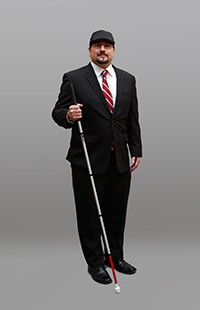If you know me, you know that I am a big proponent of using the white cane or the long white cane. I speak around the United States to youth and adults who are blind or visually impaired about employment, postsecondary education, and various other topics. I couldn't do it without the training I received in the area of orientation and mobility (O&M). I received my first white cane from an O&M instructor from the State of New Jersey's Commission for the Blind and Visually Impaired. I can't say it was love at first sight, but I definitely gained confidence in myself, the use of the white cane, and my skills over the years. The NJ Commission for the Blind and Visually Impaired is a state vocational rehabilitation agency, and these services need to be protected. You can find articles on protecting these services in the revised section, Protecting Specialized Services.
Truthfully, I probably should have started using the white cane all of the time much earlier than when I chose to do so. A wise man, Mr. Purvis Ponder (former Florida State University O&M program coordinator) told me that you can't make someone use the cane all of the time, but you can encourage them to use it and allow them to choose. I can think back to a couple of moments in particular that encouraged me to use my cane all of the time. One was stepping off what I thought was a curb onto a surface, but it was actually a four-foot drop onto another sidewalk. Luckily, I wasn't badly hurt from this and caught myself. I was left with scraped hands and a bruised ego. Not long after that, I stepped off another step onto sand, and it turned out to be a three-foot drop. Again, I was fine, but these incidents made my decision for me.
Joining the Cane Gang
While working with a postsecondary preparation program, I unoriginally called a group of students with white canes (and myself) “The Cane Gang,” instead of a chain gang. You get a bunch of people walking together with white canes and it is a lovely sight to me. I think there is thing of beauty in a good traveler using a white cane, and I really appreciate that.
I can remember explaining my consistent use of my cane to acquaintances, and they typically understood. The real obstacle was my own adjustment to using the cane and a comfort in explaining it. If I had started using a cane consistently earlier, I might have fewer bumps on my head and bumps legs from walking into fire hydrants—believe me, a fire hydrant can really hurt. My white cane, affectionately nicknamed "Slim," offers me protection and the ability to detect those objects. My white cane provides identification to drivers and causes them to think a little harder about making that illegal right turn on red or not stopping at a crosswalk.
White Cane Safety Day
White Cane Safety Day is quite important as it is about creating awareness in the community about the use of the white cane and the laws protecting white canes users while crossing the street. On October 15 each year, you will possibly find events in your local area around creating awareness and enforcing these important laws. Every so often, I hear about someone who is blind or visually impaired who is hit by a car while using a white cane. This hits home for me, as I have been hit by two cars in my life while using a white cane. One was a more serious incident where I ended up on the hood and windshield, even though I was crossing the road properly. I rolled off, and the driver didn't even open the window or stay to help. Instead, I limped my way to a local business in tears. Those were good times (sarcasm)!
If you love your white cane or want to support those who do, take the time to visit the American Foundation for the Blind's Directory of Services, and find organizations in your area that are hosting events to celebrate White Cane Day.
Be sure to also check out our orientation and mobility resources for adults who are new to vision loss on VisionAware.org and for families of children who are blind or visually impaired on FamilyConnect.org, too!
